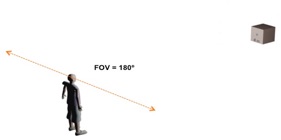Augmenting the Divergence Angle value causes an increase on the roundness feeling of our shot, but we should keep this value equal or less than 1.00 degrees, to avoid visual discomfort.
Screen Parallax and the Projection Factor
Screen Parallax is the distance between the same point of the same stereo object photographed and project in a screen.
If you think this distance as a segment, you will see that this segment will shrink visually as you move away from and increases if you moove close to the screen, increasing and/or reducind Stereopsis to the Viewer.
So we need to calculate this factor by knowing the Screen Width and the Distance of the Viewer from the screen.
On a stereo projection if you come closer to the screen you will favor the sense of Roundness or Volume on the objects being shown, if you move away from the screen you will favor the sense of Depth of the scene.
Most films in stereo are mastered for an optimum screen size of between 25 to 40 feet wide, from a recommended viewer distance of 1.5 to 2 screen heights to give viewers just over a 60 degree field of view, with an average horizontal displacement of 2% of screen width, a number which varies from shot to shot. That's a widely acknowledged comfortable 3D viewing experience.
Smaller screens and larger screens factor in, but the more important number to understand is horizontal viewing angle, which is determined by the distance of the viewer to the screen. If we view (for example) an HD 1920 x 1080 pixel HD image projected onto an approximately 40’ x 22.35 ’ movie screen from a distance of one and a half screen heights (or about 33.5’) trigonometry tells us our horizontal viewing angle is approximately 62 degrees, yielding an average of just over 30 pixels per degree. At a viewing distance of 33.5', a 2% of screen width in displacement yields about 38.4 pixels or just under 10", a comfortable and sustainable viewing experience in 3D. Theater patrons who sit closer than 1.5 screen heights away, have more trouble merging that amount of on screen object divergence, patrons further away have less trouble, and the folks sitting at the back of the theater complain that there is not enough 3D.
It is important to note that the original design spec for the 1920 x 1080 HD Television standard called for a viewing distance of 3.5 screen heights away, yielding about the same TV viewing experience that one gets by sitting at the back of a large theater. So we sometimes push the on screen divergence a bit to accommodate more viewers, going up to 3% displacement (and at times even more), frequently at the expense of the audience members sitting in the front part of the theater, partly in return for a better effect from the Blu-ray release to be viewed on TV.
If a viewer sits 1.5 to 2 screen heights away from whatever sized screen, they will usually have the best theatrical 3D viewing experience. In stereo projection, if you move closer to the screen you will favor the sense of roundness or volume on the objects being shown, if you move away from the screen you will favor the sense of Depth of the scene.
Unfortunately, the same content frequently doesn't exhibit the same amount of stereopsis in TV viewing or on the smaller screens that we normally view from a further distance ratio.
The Stereographic Calculator
It is clear that when shooting stereo content we are not going to adhere to the ideal measurements of the Ortho Stereo Model and we are going to change lenses and distances artistically.
It is the function of the Stereographic Calculator to compensate for these changes by giving the stereographer settings to keep our stereo content within the proper parameters of comfortable viewing.

























